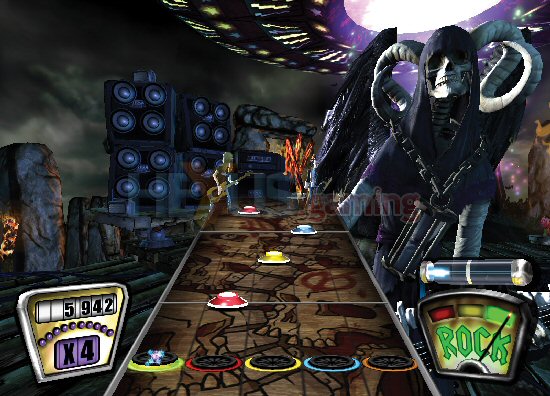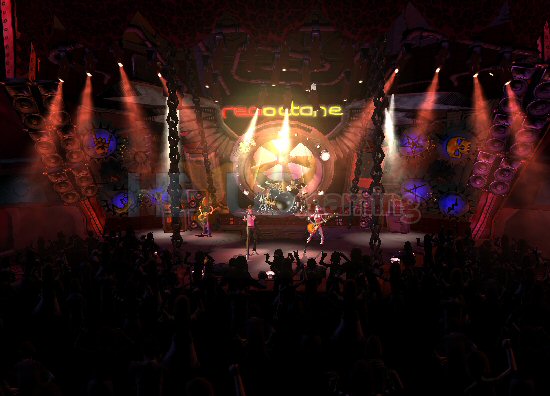Fill up the Rock metre!
In addition to hitting notes in time to the music there is also a rock metre on screen. When you hit the notes, your Rock Meter goes up, the crowd cheers more, the music gets louder. You miss notes, you hear a "plunk" dead sound, the crowd groans sometimes, the music gets quieter and dies off, and eventually you get booed off the stage if you are bad enough
Located above the Rock Metre is the Star Metre. By hitting specifically labelled notes, you can add power to this meter. Once it fills to the halfway mark, you'll be allowed to use Star Power. This power is helpful in two ways. First, it gives you a crowd boost so they cheer more feverishly and jump up and down, generally having a great time. However, it also serves as a multiplier, giving you the chance to rack up some serious points as you play. To access this power, you simply need to tilt the neck of the guitar towards the ceiling, jerking the instrument upwards as if you really were rocking with the song; there's a tilt sensor in the device that allows the game to know when you've done this. The guitar is pretty sensitive and occasionally I've been setting off Star Power without meaning to, but that's more about how the game manages to draw you into the song and take over the way you physically move about when playing tracks; I just can't keep still. You really do need to feel a song in order to gain those high scores.
 Click for larger image
Click for larger imageThe final meter is the Score Metre. Composed of two different elements, this gauge shows you your current score, as well as your current multiplier. The more notes you play in progression without missing, the better your multiplier and the higher your score. Ideally, you want to have a huge multiplier in place before activating Star Power. At the end of the song, should you survive it, you'll be graded and awarded depending on how well you did. Points mean cash, which can be spent in the store where you can buy new tracks from unknown artists, new guitars and new characters. The guitars and characters are purely cosmetic; they don't give you any advantage in the game, but the 25 or so extra tracks means that you'll be rocking until the sun goes down.
 Click for larger image
Click for larger imageThe musical selections are varied. I've only heard of a handful of these tracks, although once I started playing I immediately recognised many of the tunes, for example: I didn't know that the theme from Top Gear was called 'Jessica'. There are some classic tracks with some classic riffs that I'm never tired of playing, such as 'Sweet Child 'O Mine' by Guns N Roses and 'Message in A Bottle' by the Police. If I have one complaint about Guitar Hero II it’s the fact that it's extremely difficult, unless you're willing to invest some serious time. I'd compare it to when I first started to teach myself the guitar, but would come across stumbling blocks where it became frustrating as I felt I couldn't progress without repeating the same thing over and over again for many days. There's always the easy mode to fall back on when the going gets tough, and if you are willing to keep practising the satisfaction that you gain for completing a song on the higher levels is just amazing. Don't practice too hard though! Play Guitar Hero II for too long and your wrists will ache more than a man who's just set the world masturbation record. The visuals are also very bright and the game requires so much concentration, as you watch the moving conveyer belt, that it really does hurt your eyes if you play it for too long.









